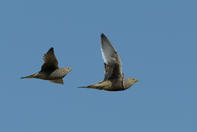
Name
Namaqua Sandgrouse - Pterocies namaqua
Namaqua Sandgrouse Appearance
Namaqua sandgrouse have light brown plumage, with rows of white specks and some darker mottling. The male has a buff coloured throat and head, with a dark brown and white band across the chest or lower neck. The Namaqua sandgrouse is the only sandgrouse with a pointed tail. Females have a streaked chest, which separates them from other sandgrouse found in the area.
Namaqua sandgrouse are around the same size as a pigeon at 26 cm in length, with the females being slightly smaller than the males.
Namaqua Sandgrouse Diet
Namaqua sandgrouse feed exclusively on small seeds.
Namaqua Sandgrouse Breeding
Namaqua sandgrouse are monogamous. Both parents incubate their two or three eggs, that are laid in a shallow scrape or depression. The female sits on the nest during the day and the male at night.
The chicks hatch at around 22 days and are precocial, but are unable to fly for around one month from hatching, but they are able to run with their parents. After around one month, the chicks grow adult feathers and are able to fly. Both parents care for their young.
Namaqua Sandgrouse Behaviour
As with all sandgrouse, the Namaqua sandgrouse will carry water to their chicks by means of belly feathers. Whilst the chicks cannot fly, the parents need to supply them with moisture. After soaking his chest and belly feathers in water, the male will fly to the nest to let the chicks drink. This is also done by the female, but to a lesser extent, due to the fact that the female does not have the same amount of absorbent feathers as the male.
The Namaqua sandgrouse drinks and collects water between 1 and 2 hours after sunrise. They are found in flocks around water holes.
Threats
None.
Namaqua Sandgrouse Distribution and Habitat
Namaqua sandgrouse are found mostly on desert grassland, in arid or semi-arid shrubland areas. The Namaqua sandgrouse can be found in the Northern Cape, and Western Cape Provinces in South Africa. Namaqua sandgrouse are near endemic.